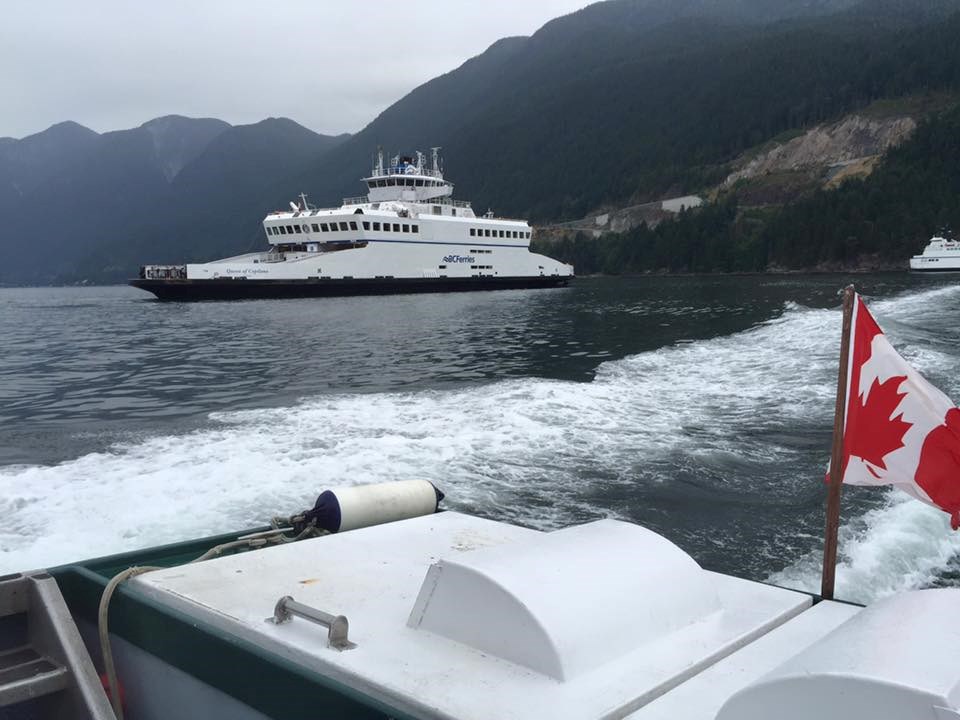“Sunshine, lollipops and rainbows, everything is wonderful on Bowen Island... thanks for the great ride home...”
Ann McDow posted these words on the Bowen Island Bus Facebook page on June 12th, and they seem to reflect the mood of the regulars om the express bus, or “super bus” run by Peter King to and from downtown Vancouver every weekday, especially those making use of the new water taxi service that takes people from Horseshoe Bay to Snug Cove at roughly 4:30 and 5:40 each evening.
Cowper says a few weeks ago, a commuter called Cormorant Marine Water Taxi Service from the bus pick-up location at Burrard and Georgia at 4:59 p.m. and asked for a water taxi to meet a group of passengers at Horseshoe Bay 20 minutes later.
Rider Daniel Cowper says that on that day, the group arrived at the dock in Snug Cove at 5:39 p.m.
“We broke the 40 minute barrier that day,” says Cowper. “Lately though, it takes closer to 45 minutes because there are so many people taking advantage of the service.”
Cowper says the other innovation that is making a huge difference to his commute is a tracking service called Glympse, which allows bus passengers to know exactly where the bus is on its route.
“This is especially effective in the summer when traffic can be really heavy and erratic,” says Cowper. “With Glympse you can see where Peter’s bus is with less than a two minute delay, so you don’t have to waste time standing on the sidewalk.”
He says TransLink has no comparable service, and that the experience is a world away from depending on the 257 express bus from downtown.
“The 257 is supposed to depart downtown at 25 minutes after the hour and 35 minutes after the hour, and when that was my way home, I took to waiting for the 25-after bus in the hopes that I might catch the 35-after bus,” says Cowper. “Even then, there were times when the bus would just blow right by because it was completely full.”
Cowper adds that since BC Ferries started following the summer schedule roughly five years ago, commuting between May to September became “almost un-endurably bad.”
“I’ve taken to giving Peter [King] an extra dollar for every trip I make on his bus because he’s saving me an hour and a half every single day,” says Cowper. “I feel like I should be paying a premium, but I am not.”
Richard Smith, who is working with the municipal transportation committee’s bus-focused sub-group, TAG (Transportation Action Group), says his experience of moving back to Bowen after time away, and suffering through the summer schedule is one of his main motivators for working to keep the bus going.
“I feel like I spent all of last summer wasting time in Horseshoe Bay,” says Smith. “There are only so many french fries you can eat, so many times you can walk back and forth across the little waterfront park. The fact that Peter’s bus and the water taxi can meet each other takes the commute from being insane to just a long shift.”
Smith says he learned about the Glympse App while at a conference in Ottawa.
“The people who were using it in Ottawa were using it to co-ordinate people in cars,” says Smith. “But because we are just waiting on one bus from downtown, it works in this context and has proved incredibly useful. It takes the uncertainty out of the commute - and I think uncertainty, and a perceived lack of control, is the reason why so many people choose to drive to work. I like to think that we can use information as a way for people to feel in control, and make the switch to this kind of service.”
Bus driver Peter King points to another innovation that is making his job easier: an app called “Waze” that monitors traffic.
“There are four routes I can take to get downtown and back, with this I get alerts about where traffic is and I can figure out the quickest route,” he says.
While the bus service has yet to meet its targeted level of ridership required to break even, and is still awaiting the official stamp of approval from TransLink to operate indefinitely (called an “Independent Transit Service” or I.T.S.), King remains optimistic about its future.
“I’ve ordered new tickets, including concession tickets for kids and seniors that will cost $2,” says King. “Right now I’m paying roughly $85 a day to bring the bus back to Bowen, and my application to the I.T.S. proposes that the bus will be parked in Horseshoe Bay during the week, that will save a lot of money.”
King says that with more commuters taking summer holidays, he’s seen a drop in their numbers but is happy to see a greater diversity of people riding the bus.
“This was branded as a commuter service during the refit [of the Queen of Capilano],” he says. “But I’d like this to be seen simply as another mode of public transportation. This is a service for everyone, and is a great alternative when the 257 is overflowing most of the time.”



